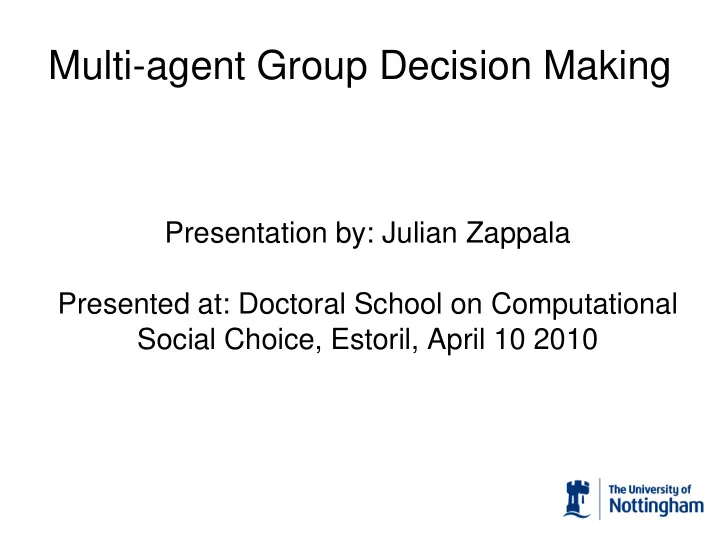

Multi-agent Group Decision Making Presentation by: Julian Zappala Presented at: Doctoral School on Computational Social Choice, Estoril, April 10 2010
Overview Introduction Problem Statement Problem Formalisation Research Context Group Decision Making in Nature Quorum Sensing/Response Future Work
Introduction Realising effective multi-agent systems requires cooperation and coordination between agents We are interested in cooperation in open environments: agents are neither centrally owned nor controlled agents may enter/leave a system at will E.g. the Internet We wish to determine what actions agents should perform: “What should the agents do?” We have looked to nature for inspiration
Problem Statement For a group of individuals, each having a preference over their possible actions, attempt to determine an allocation of one action to each individual satisfying: feasibility ; individuals are allocated actions they are able to perform, individual rationality ; no individual would prefer to leave the group rather than perform their allocated action consistency ; no individual is allocated an action which is inconsistent with the actions of others
Problem Formalisation - 1 The tuple where: G , A , S ,..., S , ,..., , C 1 n 1 n G is a set of agents, {1, , n}, n 2 A { 1 a ,..., a } is a set of possible actions, m S i A is a set of feasible actions for each agent i a a G S Action is feasible for if j i j g h a a a ,..., Joint action is feasible for agents k l { g ,..., h } if each action is feasible for each agent S is a total order over i i
Problem Formalisation - 2 C S is a set of consistency i G ' ( G ) i G ' constraints g h a ,..., a C Joint action may be consistently k l g h performed by agents { ,..., } g h The joint action by the group of a a ,..., a k l G ' { g ,..., h } is a consensus action if there agents is no consistent and feasible joint action for some a ' G ' ' G ' G group such that all agents in prefer ' ' a a ' to
Collective Action: Research Context Related work includes: SharedPlans [Grosz & Sinder, 1990] Joint Intentions [Cohen & Levesque, 1991] STEAM [Tambe, 1997] These works have not considered: open environments the explicit preferences of agents group decision mechanisms other than instantaneous unanimity
Group Decision Making in Nature Decisions faced by animal groups include: Direction of travel Timing of departure Location of e.g. nesting sites Failure to reach consensus leads to group fission an outcome which is often undesirable
Drawing Inspiration From Nature In nature decision makers are: heterogeneous: Abilities „Beliefs‟ „Desires‟ „Intentions‟ non-omniscient transient These properties are analogous to agents within open systems
Quorum Sensing & Response [QSR] Quorum sensing – determining the number of conspecifics committed to some choice Exhibited by bacteria, eusocial insects and fish Quorum response: The probability of some individual making a given choice is increasing in the proportion of individuals already having made that choice This probability increases sharply once some threshold is met
Useful Properties of QSR Information pooling Greater accuracy in comparison to the decisions of individuals Speed/accuracy trade-off High thresholds -> accurate outcomes Low thresholds -> speedy decisions Group cohesion The quorum response is thought to discourage group fission events
Future Work Natural models of QSR assume individuals follow identical responses We are interested in circumstances where this assumption is relaxed – Individually Oriented QSR Characterisation of IO-QSR, for example: Necessary/sufficient conditions for consensus Adherence to Arrovian characteristics Adherence to Condorcian characteristics
Summary Collective action selection can be represented as a social choice problem Natural systems share many properties with open multi-agent systems Many natural systems employ QSR as the group decision mechanism QSR seems a promising approach to multi- agent group decision making
Thanks for listening For further information Contact: jxz@cs.nott.ac.uk Perhaps there are some questions?
Recommend
More recommend